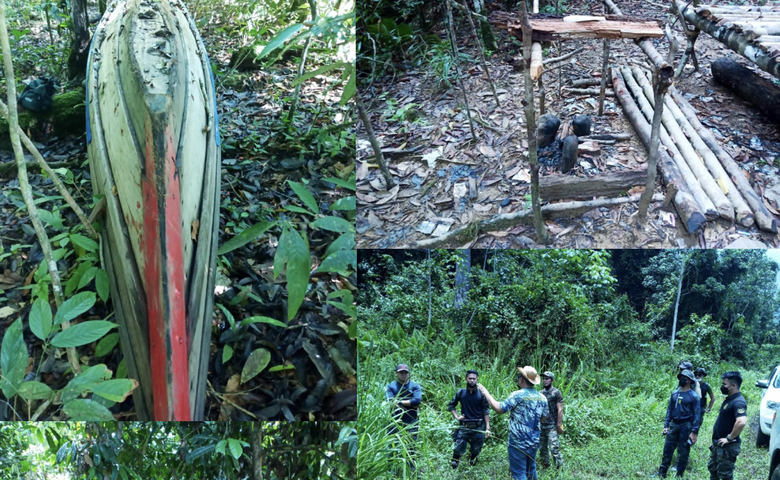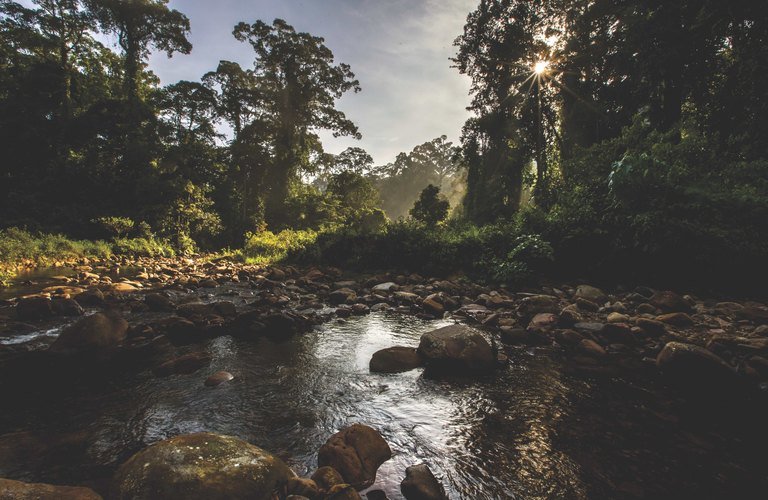DaMaI Rainforest Complex 2022/2023 Progress Report - Global Park Defense
The Danum-Maliau-Imbak Rainforest Complex or DaMaI in short, is a vast area totaling one million hectares with multiple land uses.
These areas come together to form a forest reserve, which consists of the three core conservation areas: Danum Valley Conservation Area (DVCA), Maliau Basin Conservation Area (MBCA) and Imbak Canyon Conservation Area (ICCA). To address most of the issues and concerns in managing biodiversity in DaMaI, a simple 5-year initiative was formulated and an MOU was signed in October 2017 with the state government of Sabah.
The overall goal of this initiative is the protection of biodiversity with the following objectives:
Objective #1: To support the protection of biodiversity in DaMaI Rainforest Complex.
The patrol team will be supported with technological aid such as camera traps (cellular and wildlife) with accessories, basic communication devices, and basic office hardware and software, e.g. Spatial Monitoring and Reporting Tool (SMART) & QGIS. In addition, transportation to conduct patrolling, e.g. 4WDs rental, ranger’s allowances, and other essential physical equipment will also be provided among others. Along with everything mentioned, SET hopes to support in improving the overall command system for all partners in the MoU, to enhance the protection of all protected forests in Sabah aside from DaMaI alone, in the long run.
Objective #2: To enhance the capacity of the dedicated teams and other forest rangers in DaMaI.
Under this objective, the patrol team and dedicated officers will be given basic training to implement Global Park Defense (GPD) in DaMaI. The training provided will be focusing more on technologies, e.g. SMART, QGIS, WPSWatch, and EarthRanger. Apart from that, the dedicated officer will be trained to analyze data, to update on project progress to partners during workshops, to produce high-impact reports for stakeholders, and to supervise the patrol team on the ground.
Objective #3: To support the efforts in nominating DaMaI Rainforest Complex as a World Heritage site.
This objective is designed to conduct activities that will target the local community and other stakeholders inside the DaMaI landscape. The aim was to improve the awareness on the benefits of a World Heritage site and on livelihood sustainability while reducing dependencies on forest resources, e.g. bushmeat. In addition, local communities will also be given the opportunity to participate in a study visit program to any of the protected forest reserves under SF, while learning about environmental education.
Our work in DaMal Rainforest Complex
Major progress has been achieved over the past four years to secure nearly one million acres of tropical forest and wildlife habitat in the Heart of Borneo.
Image by Paul Hilton
Prior to Global Conservation, this landscape was a collection of disparate logging concessions with three disconnected conservation areas with no real protection.
No truck, no patrols, and no ranger teams were in place to protect against wildlife poaching decimating both key species - Elephant, Banteng, Clouded Leopard, Orangutan, Hornbills, while Rhinos are extinct in Sabah.
Led by Sabah Environmental Trust (SET), Global Conservation signed a five-year MOU with Sabah Forestry Department and Sabah Foundation to deploy Global Park Defense to build a unified national park and secure a nomination for UNESCO World Heritage.
Cellular Trailcam Surveillance
On roads and trails used by poachers, a real-time network of Cellular Trailcams were deployed giving critical intelligence on illegal activities.
SMART Patrolling
Planning and executing patrols and collecting biodiversity information now is fully automated enabling intelligent decisions on how and where to deploy protection resources.
Image by Paul Hilton
Rapid Response PROTECT Team
Combining key personnel from three organizations with new patrol vehicles and park-wide communications, rapid interdictions can now respond to threats.
UNESCO World Heritage Nomination
The Federal Ministry of Tourism, Arts and Culture (MoTAC) supports the application to first make DaMaI a world heritage site (under Act 645) in order to facilitate its progression towards being accorded a UNESCO World Heritage Site status.
Image by Paul Hilton
Biodiversity Recovery
After decades of large-scale logging decimating many areas of the DaMaI Rainforest Complex, replanting of native forests is bringing back healthy habitats, and wildlife is coming back. Scientific wildlife population baseline studies and giving critical insight into the health of species and movements for corridor design.
With over 70% of Sabah state having been logged, DaMaI Rainforest is one of the last intact tropical forests with potential to conserve species and conserve for future generations.
Patrol Coverage
Since the first MOU came to an end on 31st December 2021, an extension has been proposed through 2026 to improve the protection of one of Sabah’s largest forest estates, the DaMaI Rainforest Complex. This initiative provides support for the state government to measure and solve gaps in the enforcement and protection of the protected areas. The extension also brings in Sabah Wildlife Department (SWD) to the MOU so as to strengthen the team capacity in combating illegal activities in DaMaI Rainforest Complex.
The three core conservation areas, DVCA, MBCA, and ICCA, are patrolled by dedicated rangers who’ve also received further training to boost their skills in monitoring, enforcement, and understanding of related technologies, which helps them reduce and mitigate forest crimes such as encroachment and poaching activities.
Arrests and Prosecutions
14 people were arrested suspected of illegally entering forest preserves to hunt wildlife, including protected species, after a patrol team discovered an active poacher campsite in Gunung Rara near the Nurod Urod Forest Reserve. The Sabah Forestry Department’s (SFD) Protect Unit arrested five suspects and confiscated two vehicles with sambar deer and wild boar carcasses at the Tiagau Forest Reserve, Luasong. Nine more suspects, including three locals, were arrested in the Maliau Basin Conservation Area buffer zone shortly after. Those suspects were being further investigated by SFD, and both cases are being dealt with under the Forest Enactment of 1968 and the Wildlife Conservation Enactment of 1997.
Successes in Numbers
DaMaI patrol 33 times, 35 patrol days
Joint patrol 16 times, 20 patrol days
Installed 57 camera traps
Arrested 5 poachers (one with HWW license!) Confiscated 35 live bullets and 2 shotguns
Destroyed 18 illegal camps and 2 boats
Identified 1 important hotspot - illegal gold mining
Interdiction of Deer Hunters in DaMaI Rainforest Complex Global Park Defense
January 2022: Hunters were spotted in Cellular Trailcams on the road early morning.
Deer meat was dropped in bags on the roadside as they ran from rangers on bicycles.
Poacher camp and clothing of hunters with deer meat.
The deer meat was confiscated, but the hunters managed to escape into the forest.
Global Conservation supports purchase of more vehicles
Global Conservation supported Sabah Environmental Trust and the Yayasan Sabah Group with the purchase of six ATVs and three Nissan trucks for help with their patrolling and enforcement in DaMaI.
Summary of Activities
In the last quarter of this project, activities of retrieving and sorting all camera trap data were conducted. There is a delay in sorting camera trap data due to a lack of manpower. Report writing and data analysis commenced in December - and still ongoing (Feb 2023).
Photo above shows the rangers sorting the camera trap and data.
Camera trapping summary
Only 14 camera traps had completed 6 months trap nights (180 days) (refer to camera location map - marked in yellow ring).
9 out of the 14 camera traps were successful in capturing photos of the Bornean elephant and Bornean banteng.
A total of 72 species (excluding the 2 main species) were recorded, e.g. 36 mammals, 2 reptiles and 34 birds.
Artificial Salt Lick summary
A total of 4 artificial salt lick plots (ASL) were established and studied since October 2021.
ASL 4 was removed from the study - not viable for long-term observation due to road opening for forest extraction.
A total of 13 species were recorded by camera trap, using or in presence within the ASL plots.
Preliminary Analysis Summary
The preliminary analysis was performed to answer the 4 objectives:
Objective #1: To determine the population and abundance of the two iconic species in the study area. The table below shows the frequency of sightings of species and sexes.
Species:
Bornean Banteng
Female - 354
Male - 175
Total - 529
Bornean Elephant
Female - 89
Male - 38
Total - 127
Based on this table alone, the frequency of females captured by camera trap was twice the number of males. This does not assume the total population of animals, but only indicating there are positive breeding potential of its species in Maliau Basin.
In a herd, there are more females than males.
Objective #2: To determine the body conditions of the two iconic species from available images captured by camera traps.
The data was screened to look at the body condition using the Body Condition Scoring System (BCS) for both species: Bornean Banteng and Bornean Elephant. For Banteng, the majority of the species have a body score of 3, while Elephants have almost equal body scores between 4 and 5. Based on the chart, we assume both species have good fitness. This indicates positive survivability, reproduction potential and availability of food.
Objective #3: To identify the presence and distribution of other medium and large mammals (e.g. deers, wild boars, Sun bears, etc.) in the study area.
A total of 72 species (excluding Banteng and Elephant) were recorded in study site; 36 mammals, 34 birds and 2 reptiles. All species were previously recorded in Maliau Basin, hence no new discovery.
Objective #4: To establish suitable plots for artificial salt licks that can be developed in the future as an attraction for nature-based tourism.
Local grant aquisition
In 2022, we received a local grant (National Conservation Trust Fund or NCTF) for the purchase of 4 satellite collars (2 collars fitted for females of each species, i.e. Banteng & Elephant). The collar purchased from African Wildlife Tracking.
We thank the hard work of our Partners in Conservation SET, Sabah Foundation and the Sabah Department of Forestry for contributing to combined patrols and scientific research to protect DaMaI Rainforest Complex.






























